A
Pioneer Story
About
ten kilometres east Brandon on the Trans-Canada Highway, an alert
traveler might see a sign noting “Currie’s Landing Rd.” marking a
gravel road heading south. That trail has a bit of a story to
tell.
In 1880 William Currie, who had come to Rapid City
from St. Mary’s Ontario, in the previous year, bought a quarter section
straddling the river east of Brandon, just below a well-known set of
rapids. The Brandon Rapids as they were later known, were first
identified as the Grand Rapids by HBC surveyor and manager Peter Fidler
on his 1819 map of the region. It had been used as a crossing for some
time and Mr. Currie, initially for his own convenience, decided to
establish a ferry.
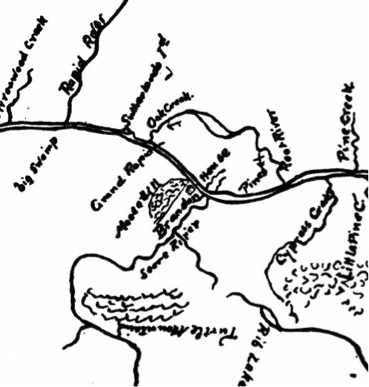
Peter Fidler was a long-term HBC employee
in the
region. His 1819 map identified the “Grand Rapids” which we now call
the “Brandon Rapids” and Moose Hill” which we call the “Brandon Hills”.
He purchased the adjoining 1/4 section on the opposite side of the
river, sank two poles in each bank, joined them by wires for a pulley
and a scow.
The area was soon to see a rush of settlers and his ferry was soon a
vital spot on the trail west. His location at the foot of the
most lengthy and challenging rapids on the Assiniboine also presented
another opportunity. Here, the Assiniboine which gently twisted and
turns for most of its 1070 kilometres makes a steep decline of over
three metres in about a kilometre. For the first steamboats to ascend
the Assiniboine it was the end of the line. And although enterprising
captains did find ways to force their craft through those rapids, in
lower water it remained the head of navigation.
That meant that it became the entranceway to the new lands.
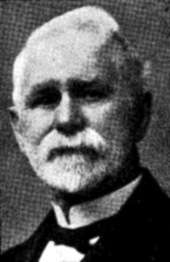
William Currie
Mr. Currie lived on the site and operated the Curries Landing ferry
until 1893 when he sold farm and ferry and moved his family to Brandon.
There he became a bailiff and later an insurance agent until he passed
away in 1941, at ninety-three years of age. At that time he was the
eldest insurance agent in Canada.
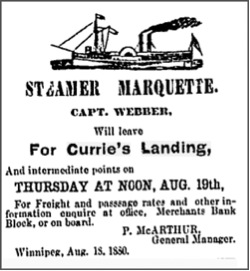
Winnipeg Times Aug 18, 1880
The
Landing
By the end of 1880 Currie’s Landing (also called “Rapid City Landing”)
had already become an important staging area for trips overland to new
settlements like Souris, Millford, Souris City, and of course Rapid
City. Goods were portaged over the rapids to other boats or taken
by horse drawn vehicle, or at times man on foot for many miles. A store
was established for local needs.
Probable site of Mr.
Currie’s ferry, viewed from
the landing side. The
steamboat dock was nearby.
Besides the incoming commodities, grain and other produce for a short
time were shipped east by river boat. The first homesteaders arrived in
western Manitoba by ox cart and covered wagon, but the riverboat proved
cheaper even though the journey by water was much longer because of
bends in the river. The cart trail from Winnipeg to Brandon was a
hundred and fifty miles but it was nearly five hundred miles by the
Assiniboine River.
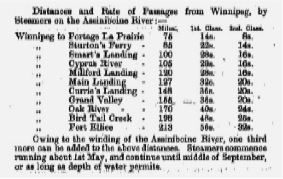
Wyatt, George H. A reliable guide
for
settlers, travellers &
investors in the city of Winnipeg, Manitoba and the new
North-West (Toronto: s.n., 1881.)

Winnipeg Times Sep. 6, 1880
The trip from Winnipeg to Fort Ellice took a week. From Winnipeg to
Brandon took three days. Passengers would often get out and walk
the “short-cut” as the boat navigated the wide meanders.
Decades later William’s daughters, Lottie and Nettie recalled one of
the early steamboats arriving from Winnipeg after a journey that
was longer and more arduous than anticipated. The crew arrived at
Curries Landing minus provisions. The Curries' farm home had little to
offer a crew of starving men, but the pioneers' hospitality and
ingenuity came to the fore. Flour and the remainder of gallon tin of
baking powder, sent from Ontario, was made into hundreds of biscuits
baked in relays while a whole cured ham was boiled an a feast ensued.
Miss Lottie also recalled that the Alpha often spent time at her dad’s
landing. Once, while waiting for a week while waiting for parts
from Winnipeg the crew spent time playing baseball and otherwise
entertaining themselves.

Back in 1878, the first steamboat to ascend the Assiniboine past
Portage la Prairie had stopped at the bottom of the rapids, judging
them too difficult for navigation. Those were years of high water and
they must have looked formidable. They were over a kilometre in length
and the strong current would be too much for the heavily laden and
cumbersome steamship.
In 1879, the Marquette under Captain Webber, also stopped and turned
back at the rapids, but his examination of them must have convinced him
that ascent was possible. The profits to be made from trade
further up river made it worth the effort. On his next trip up river
later that spring, after a great deal of effort, he was able to
negotiate the rapids and become the first steamer to reach Fort Ellice.
By that time riverboat travel had a long history in the west.
Experience on the variable western rivers, especially on the Missouri
and its tributaries, had prompted some solutions to shallow water
navigation and to dealing with rapids.
These were large boats. Many would carry 50 passengers and 170
tons. They were about 200 feet long and designed for shallow
water – as low as a 2 or 3 feet, They burned logs for fuel. They
sometimes had to be poled over sand bars - or helped with he use of a
donkey engine. Each boat had such an engine, which wound a rope around
a drum. When the rope was attached to some tree on the bank ahead
the boat could be hauled forward. Passengers would have to pitch in
with poles. Some would disembark, or even unload some cargo to raise
the boat.
Rapids could be conquered by using the same concept. The “deadman” was
buried upstream. Any combination of a donkey engine, man-power, and
pushing from the rear, might be used to get the boat through. Records
show that this might take some time (14 hours is mentioned) and many
passengers would get off and walk to Grand Valley or Brandon, and wait
for their luggage there. As the rope became old it was prone to break
causing more delays. The Alpha once took four days on the rapids.
The Winnipeg Daily Times feature story on the Marquette's
ground-breaking trip to Fort Ellice in the spring of 1879 offers a
gripping account of the time-consuming attack on the rapids near
Brandon, indicating that they "extend for two miles and very
swift". During the difficult ascent Mr. William Griggs, while
returning to the vessel in a small craft after fixing a line to the
"dead man" for the purpose of winching the vessel along, fell overboard
and was saved only by the quick thinking action of a co-worker who
grasped his hair as he floated past in the strong current. [35]
Just another work day on the river!
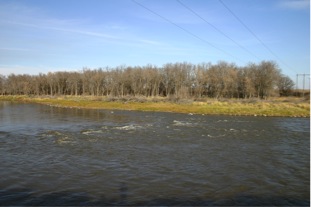
The rapids may not look formidable today –
but imaging an overloaded
steamboat fighting a springtime. Anyone who witnessed the Assiniboine
Flood of 2011 knows how much current the river can generate in high
water.

That voyage opened up the river upstream for commercial travel and
signaled the beginning of a short but interesting era in the history of
Westman. Steamboat travel flourished for only a few years before
the railway took over, but between 1879 and 1885 traffic was constant
during the spring and early summer. One can only speculate at the
amount of profit these journeys generated. The cost of a ticket
from Winnipeg to Brandon at $10 seems reasonable enough by today’s
standards, but it was quite high in relation to the dollar’s purchasing
power at the time. Surely the owners and operators could see that the
coming of the railway would effectively kill their business. Were the
profits large enough to justify the expense of purchasing these boats
and moving them into the interior of a continent? There must have
seemed to be some future to these early entrepreneurs. Even the
CPR must planned for the continued existence of steamboat travel when
it constructed its first bridge at Brandon. It was built so that it
could swing aside to let them pass.
The landmarks became familiar. The Manitoba Gazette reporter who made
the first trip (1879) on the Marquette recorded that they landed at
“Cyprus” River to unload freight. He noted the sand hills and detailed
progress between there and Currie’s Landing. Mention was made of
“Sand Hill Bend”, Blake’s Bluff, Webber’s Grove and Crawford’s
Landing. He commented on the scenery of Little
Saskatchewan mouth and contrasted it with the lack of trees in the
Brandon Rapids area.
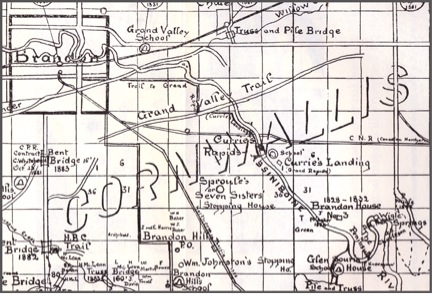
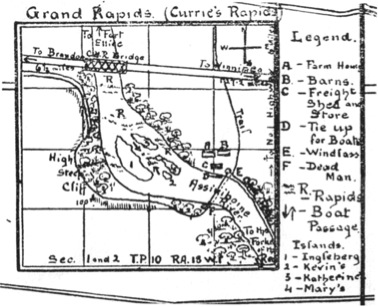
Kavanaugh’s Map
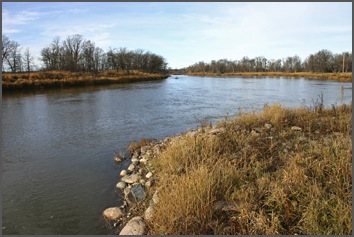
Looking upstream from the site of Currie’s
Ferry, (Point E on the map
above), towards the rapids.
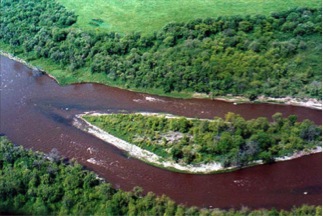
The channels around the
island are
still quite recognizable as those
marked on Kavanaugh’s map, although the riverbed is much altered
by recent floods.
Mr. Currie and his brother R.W. Currie built a
landing dock that became
a thriving centre of activity. Quantities of merchandise and supplies
of all kinds were
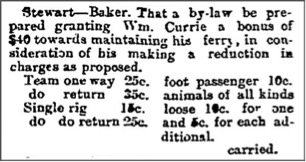
Winnipeg Times, April 30, 1880

Winnipeg Times, Sept. 6, 1880
The last voyage of Marquette to the Brandon area in 1882 was
noteworthy. The entire valley area known as the flats was
flooded. Near Grand Valley high winds caused such high waves that
passengers were frightened. “ It was feared that some large body
of water from the Northwest Territories had found it’s way into the
Assiniboine” (Brown). The river was a mile wide.
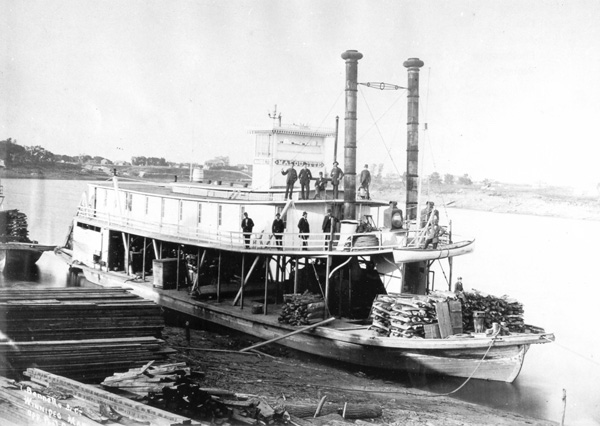
The Marquette
The
Community
Aside from being an important part of the region’s transportation
infr astructure, Curries Landing became a community.
In the early 1880’s the Brandon Sun would regularly report on
happenings. On the 11th of September it was noted that, “Miss Maggie
Currie, who was a candidate at the recent examinations for a third
class certificate has been very successful, having,..”, 1884
And before long, more news about Maggie:
Brandon Sun,
Aug. 7, 1886
Currie’s Landing School District #183 served the neighbourhood,
beginning in 1884.
Mr. Currie became a recognized leader in the community, serving as an
auditor for the municipality and providing a boat for holiday
excursions on nearby Lake Clementi. He was also named a Pathmaster for
the Municipality in 1884. Pathmasters saw that the roads were built and
maintained through a community service model – where each citizen had
to donate a few days time.
As the Currie home was the only one in the district to be graced with a
piano the church services were held there on Sunday mornings, with
people from every denomination in the whole area attending. Often
guests stayed on for dinner and supper to participate in the
never-ending Currie hospitality.
A Brandon Sun article of Jan. 14,1963 records an interview with two
members of the Currie family, Miss Nettie, who had recently celebrated
her ninety-sixth birthday and Miss Lottie, who was in her eighty-sixth
year.
They recalled Lottie's thrill as a young girl at being allowed by her
father to operate their ferry across the Assiniboine on Saturdays,
there by augmenting her allowance. Lottie told of her delight at
receiving a "fortune" of thirty-five cents for transportation of an
unknown passenger. Ministers and Indian people were always allowed free
ferrying and, when it was later ascertained that the traveller in
question was the new Methodist minister for Chater, her father required
that she abide by the policy and return her earnings.
By 1882 regular rail service was established to Brandon, and although
train trips were not as romantic and adventurous as a riverboat rides,
the schedule proved to be much more reliable and convenient. The
Marquette was taken off the river in 1883. Although there was still
some river traffic until the Alpha made its last trip in the spring of
1885, and the ferry continued to be useful to local traveller, Currie’s
Landing was quickly losing its importance.
The
End of
An Era
The steamboat era was over. 1885 saw the rail line extended as
far
west as Glenboro, so even on the lower Assiniboine the boats were
becoming obsolete.

June 14, 1882,
Winnipeg Times

June 4, 1885
Riverside locations lost their appeal, and to this day one can canoe
down the Assiniboine from Brandon to Spruce Woods without seeing more
than a few homes. The ever-changing river quickly washed away any
signs of the landing.
In 1923 the old two-story storehouse was in need of repair, so the
owners,( the Sibleys) removed the top floor and did some rebuilding.
Mr. Wyton who took over the ferry operation from the Currie’s soon
found it was no longer in demand. He tore it apart and used the
material as flooring for his barn.
Buildings deteriorated and some were eventually burned. A modern
home
with outbuildings marks the Currie’s Landing site today, with little
evidence to remind us of the place it once held in settlement times.

Sources
Kavanaugh,
Martin, The Assiniboine Basin, The Gresham Press, Old Woking, Surrey,
England 109
Wyatt, George H. A reliable guide for settlers, travellers &
investors in the city of Winnipeg, Manitoba and the new
North-West (Toronto: s.n., 1881.)
Municipal Memories, Cornwallis Centennial Committee, 1884
The Story of Brandon Hills, Brandon Hills History Committee, 1979
The Winnipeg Times – as cited
The Brandon Sun – as cited
|